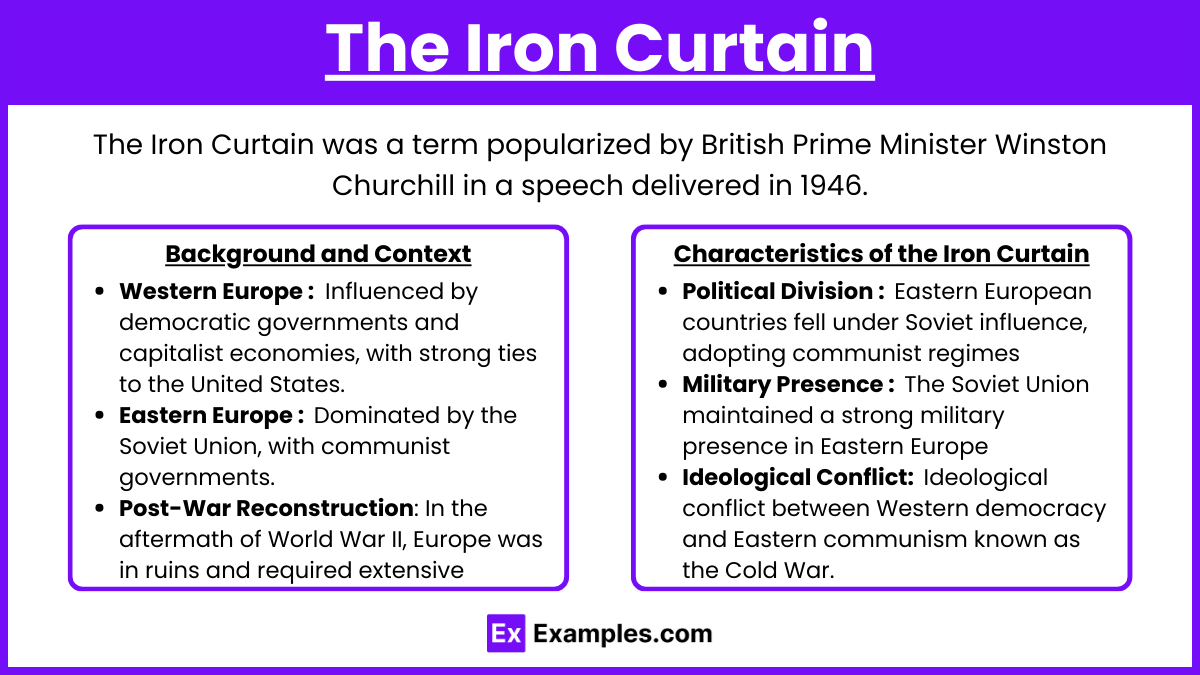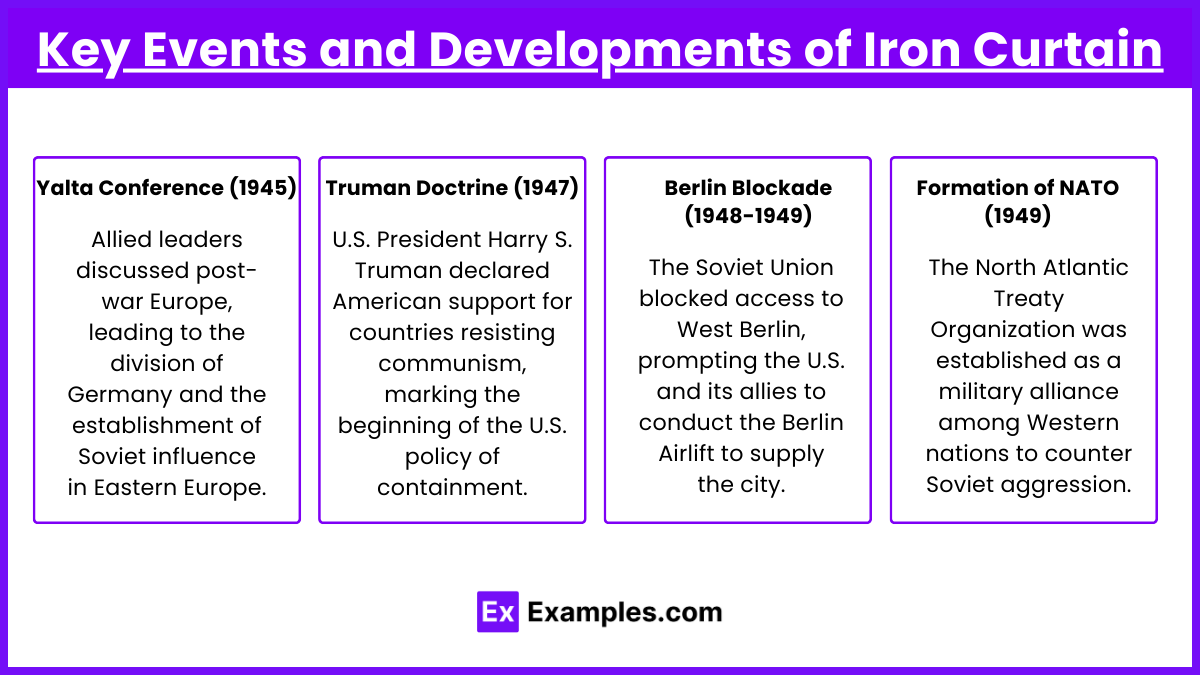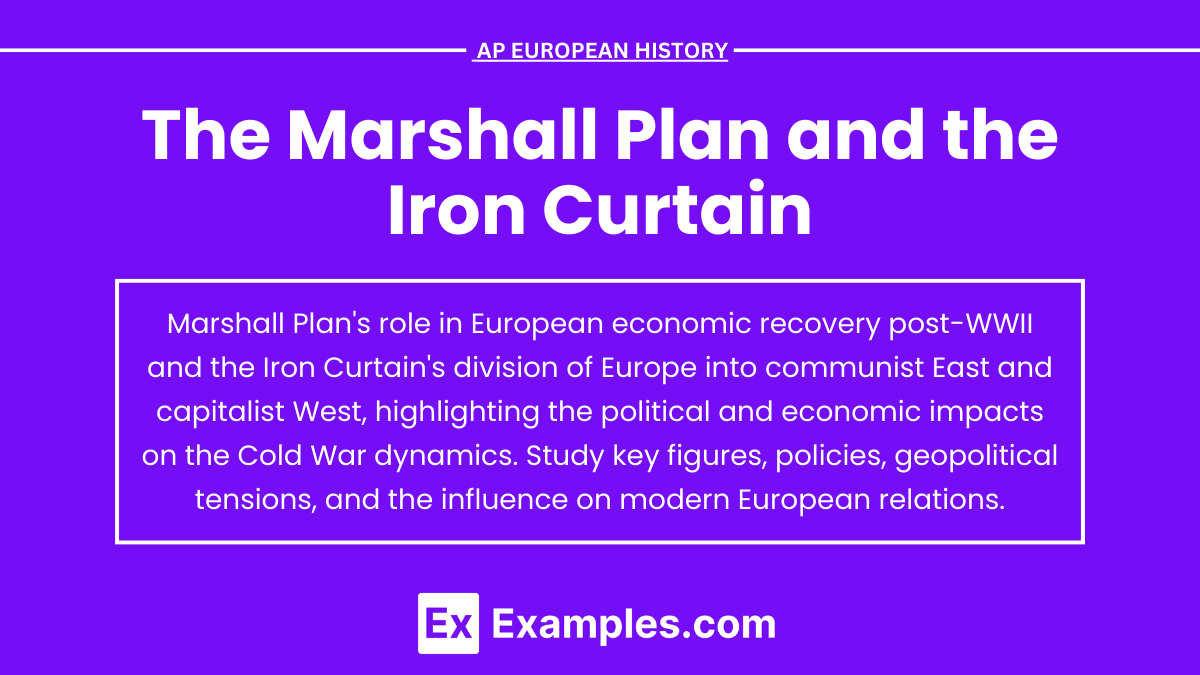The Marshall Plan and the Iron Curtain were crucial developments in the aftermath of World War II, significantly shaping the geopolitical landscape of Europe. The Marshall Plan, initiated by the United States, aimed to rebuild and stabilize war-torn Western Europe. Meanwhile, the Iron Curtain, a term coined by Winston Churchill, represented the division between the Soviet-controlled East and the democratic West. Understanding these events is essential for mastering AP European History, as they highlight the ideological and political tensions of the Cold War era.
Learning Objectives
By studying "The Marshall Plan and the Iron Curtain" for the AP European History exam, you should understand the post-World War II reconstruction of Europe, including the objectives and impacts of the Marshall Plan on Western Europe. Additionally, grasp the significance of the Iron Curtain as a symbol of Cold War divisions, the geopolitical and ideological conflicts between the Western democracies and the Soviet bloc, and the resulting political, economic, and social consequences for both Eastern and Western Europe during this period.
The Marshall Plan

Definition and Purpose
The Marshall Plan, officially known as the European Recovery Program (ERP), was an American initiative aimed at aiding Western Europe after the devastation of World War II. Named after U.S. Secretary of State George C. Marshall, it was announced in 1947 and implemented in 1948.
Goals of the Marshall Plan
Economic Recovery: Rebuild war-torn regions, remove trade barriers, modernize industry, and improve European prosperity.
Political Stability: Prevent the spread of communism by stabilizing European economies and governments.
Humanitarian Aid: Alleviate poverty and suffering caused by the war.
Features, Impact and Benefits of Marshall Plan

Key Features
Financial Assistance: The U.S. provided over 140 billion in today's dollars) in economic aid to Western European countries.
Technical Support: Offered expertise and technological aid to boost productivity and efficiency.
Promotion of Free Trade: Encouraged cooperation and trade among European nations to foster economic interdependence and unity.
Impact on Europe
Economic Growth: The plan significantly accelerated economic recovery in Western Europe, leading to an era of unprecedented growth and prosperity.
Political Influence: It strengthened democratic governments and reduced the appeal of communist parties, which were gaining ground in several countries.
European Integration: Laid the groundwork for future economic cooperation, eventually leading to the creation of the European Union.
U.S. Benefits
Economic: Revitalized European markets for American goods, boosting the U.S. economy.
Political: Strengthened political alliances and established the U.S. as a dominant power in Western Europe.
Strategic: Contained the spread of communism, aligning Western Europe with U.S. interests during the early Cold War.
The Iron Curtain

The Iron Curtain was a term popularized by British Prime Minister Winston Churchill in a speech delivered in 1946. It referred to the political, military, and ideological barrier that separated the Soviet-dominated Eastern Europe from the Western European countries that were free from Soviet control.
Background and Context
After World War II, Europe was divided into two spheres of influence:
Western Europe: Influenced by democratic governments and capitalist economies, with strong ties to the United States.
Eastern Europe: Dominated by the Soviet Union, with communist governments and centrally planned economies.
Post-War Reconstruction: In the aftermath of World War II, Europe was in ruins and required extensive rebuilding efforts.
Characteristics of the Iron Curtain
Political Division: Eastern European countries fell under Soviet influence, adopting communist regimes, while Western European countries maintained democratic governance.
Military Presence: The Soviet Union maintained a strong military presence in Eastern Europe, with the Red Army stationed across the region to enforce Soviet control.
Ideological Conflict: The Iron Curtain symbolized the ideological conflict between Western democracy and Eastern communism, leading to a prolonged period of tension known as the Cold War.
Key Events and Developments of Iron Curtain

Yalta Conference (1945): Allied leaders discussed post-war Europe, leading to the division of Germany and the establishment of Soviet influence in Eastern Europe.
Truman Doctrine (1947): U.S. President Harry S. Truman declared American support for countries resisting communism, marking the beginning of the U.S. policy of containment.
Berlin Blockade (1948-1949): The Soviet Union blocked access to West Berlin, prompting the U.S. and its allies to conduct the Berlin Airlift to supply the city.
Formation of NATO (1949): The North Atlantic Treaty Organization was established as a military alliance among Western nations to counter Soviet aggression.
Consequences and Legacy
The Iron Curtain remained in place for over four decades, leading to:
The Cold War: A period of geopolitical tension, characterized by espionage, propaganda, and proxy wars between the U.S. and the Soviet Union.
Division of Germany: Germany was divided into East Germany (GDR) and West Germany (FRG), with Berlin itself split into East and West.
Cultural and Social Divide: The Iron Curtain created stark contrasts in living standards, freedoms, and ideologies between Eastern and Western Europe.
End of the Iron Curtain
The Iron Curtain began to disintegrate in the late 1980s, leading to:
Gorbachev’s Reforms: Soviet leader Mikhail Gorbachev introduced policies of glasnost (openness) and perestroika (restructuring), leading to greater political freedom in Eastern Europe.
Fall of the Berlin Wall (1989): The symbolic end of the Iron Curtain, as East and West Germans dismantled the wall that had divided Berlin for 28 years.
Collapse of the Soviet Union (1991): The dissolution of the Soviet Union marked the end of communist rule in Eastern Europe and the beginning of a new era of European integration.
The Marshall Plan and the Iron Curtain were pivotal in shaping the post-World War II landscape of Europe. The Marshall Plan facilitated economic recovery and political stability in Western Europe, while the Iron Curtain symbolized the division and ideological conflict that defined the Cold War era. Understanding these historical phenomena is crucial for grasping the complexities of European history and the development of contemporary international relations.
Examples
Example 1: Post-War European Recovery
Marshall Plan: Initiated by the United States in 1948, the Marshall Plan provided over 130 billion in current dollars) to help rebuild Western European economies after the devastation of World War II.
Iron Curtain: Coined by Winston Churchill in 1946, the term "Iron Curtain" referred to the division between Western Europe, influenced by democratic governments, and Eastern Europe, controlled by Soviet communism.
Example 2 : Economic Aid and Political Tensions
Marshall Plan: Aimed to stabilize European economies, prevent the spread of communism, and foster political stability by promoting economic growth and cooperation among Western European nations.
Iron Curtain: Represented the ideological conflict and physical boundary separating the Soviet bloc and the West, leading to heightened political tensions and the eventual establishment of NATO and the Warsaw Pact.
Example 3 : Impact on Germany
Marshall Plan: Western Germany received significant aid from the Marshall Plan, which contributed to its rapid economic recovery and the eventual formation of the Federal Republic of Germany in 1949.
Iron Curtain: Eastern Germany, under Soviet influence, became the German Democratic Republic in 1949, leading to a divided Germany with contrasting political and economic systems until reunification in 1990.
Example 4 : Cultural Exchange and Isolation
Marshall Plan: Encouraged cultural exchange and cooperation among Western European nations and the United States, fostering a sense of unity and shared purpose.
Iron Curtain: Restricted cultural exchange between Eastern and Western Europe, leading to limited interaction and a growing sense of isolation among countries behind the Iron Curtain.
Example 5 : Long-Term Legacy
Marshall Plan: Laid the groundwork for the European Union by promoting economic integration and cooperation among Western European nations, ultimately contributing to decades of peace and prosperity in the region.
Iron Curtain: Symbolized the Cold War era's division, which persisted until the fall of the Berlin Wall in 1989 and the subsequent collapse of the Soviet Union, marking the end of the Iron Curtain and the beginning of a new era in European history.
Multiple Choice Questions
Question 1
Which of the following best describes the main purpose of the Marshall Plan?
A. To provide military aid to European countries after World War II
B. To support the Soviet Union in rebuilding after the war
C. To provide economic aid to Western European countries to prevent the spread of communism
D. To establish a common currency for Europe
Answer: C. To provide economic aid to Western European countries to prevent the spread of communism
Explanation: The Marshall Plan, officially known as the European Recovery Program, was an American initiative that provided over 130 billion in current dollar value) in economic assistance to help rebuild Western European economies after the end of World War II. Its primary goal was to prevent the spread of communism by revitalizing the economies of these nations, making them more stable and less susceptible to communist influence.
Question 2:
The term "Iron Curtain" was popularized by which of the following figures?
A. Joseph Stalin
B. Winston Churchill
C. Franklin D. Roosevelt
D. Harry S. Truman
Answer: B. Winston Churchill
Explanation: Winston Churchill popularized the term "Iron Curtain" in a speech he delivered on March 5, 1946, at Westminster College in Fulton, Missouri. In his speech, Churchill warned of the division of Europe by the Soviet Union's influence in Eastern Europe, metaphorically describing this division as an "Iron Curtain" descending across the continent, separating the communist Eastern bloc from the Western democracies.
Question 3:
How did the Marshall Plan impact the relationship between the United States and the Soviet Union?
A. It improved their relationship by fostering economic cooperation
B. It had no significant impact on their relationship
C. It worsened their relationship by increasing tensions and competition
D. It led to a formal alliance between the two nations
Answer: C. It worsened their relationship by increasing tensions and competition
Explanation: The Marshall Plan heightened tensions between the United States and the Soviet Union, exacerbating the Cold War. While the U.S. aimed to stabilize Western Europe and prevent the spread of communism, the Soviet Union viewed the plan as an attempt to undermine its influence in Eastern Europe. The USSR responded by tightening its grip on Eastern European countries and rejecting the aid, leading to further division and competition between the two superpowers.


